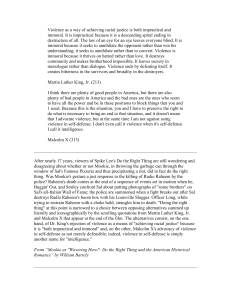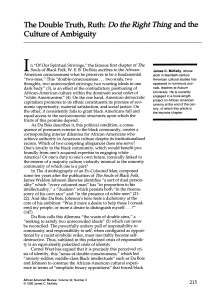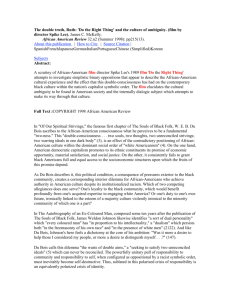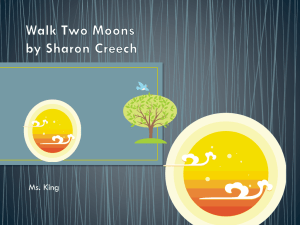Violence as a way of achieving racial justice is both impractical and
advertisement
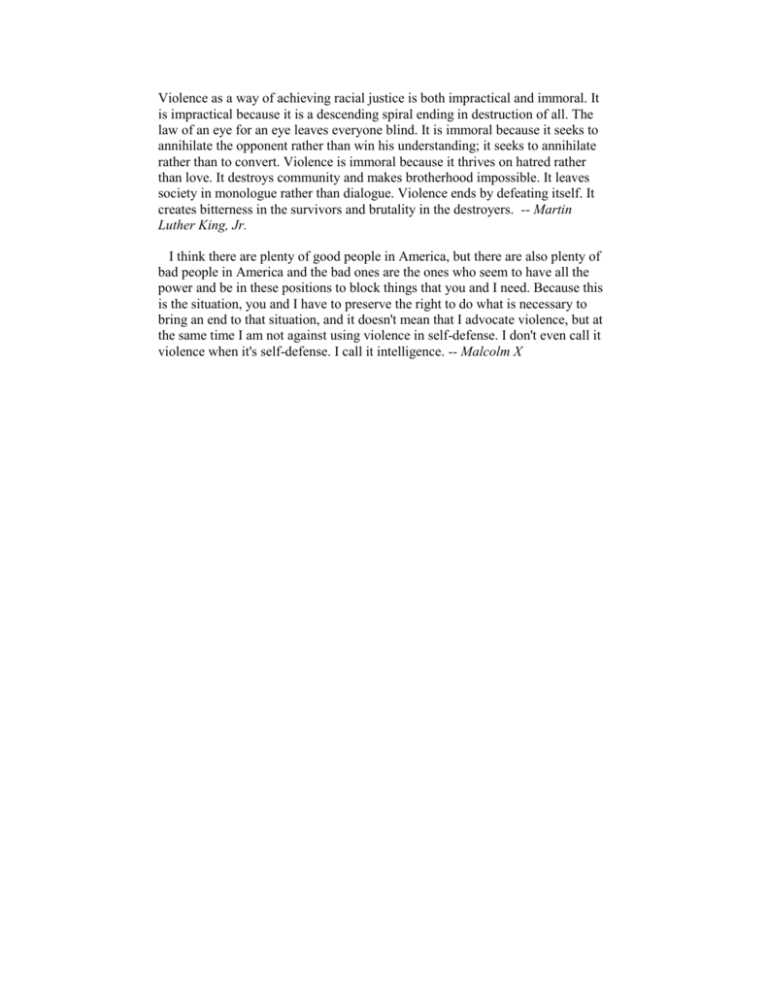
Violence as a way of achieving racial justice is both impractical and immoral. It is impractical because it is a descending spiral ending in destruction of all. The law of an eye for an eye leaves everyone blind. It is immoral because it seeks to annihilate the opponent rather than win his understanding; it seeks to annihilate rather than to convert. Violence is immoral because it thrives on hatred rather than love. It destroys community and makes brotherhood impossible. It leaves society in monologue rather than dialogue. Violence ends by defeating itself. It creates bitterness in the survivors and brutality in the destroyers. -- Martin Luther King, Jr. I think there are plenty of good people in America, but there are also plenty of bad people in America and the bad ones are the ones who seem to have all the power and be in these positions to block things that you and I need. Because this is the situation, you and I have to preserve the right to do what is necessary to bring an end to that situation, and it doesn't mean that I advocate violence, but at the same time I am not against using violence in self-defense. I don't even call it violence when it's self-defense. I call it intelligence. -- Malcolm X After nearly 17 years, viewers of Spike Lee's Do the Right Thing are still wondering and disagreeing about whether or not Mookie, in throwing the garbage can through the window of Sal's Famous Pizzeria and thus precipitating a riot, did in fact Do the Right Thing. Was Mookie's gesture a just response to the killing of Radio Raheem by the police? Raheem's death comes at the end of a sequence of events set in motion when he, Buggin' Out, and Smiley confront Sal about putting photographs of "some brothers" on Sal's all-Italian Wall of Fame; the police are summoned when a fight breaks out after Sal destroys Radio Raheem's boom box with his Louisville Slugger. Officer Long, while trying to restrain Raheem with a choke hold, strangles him to death. "Doing the right thing" at this point is narrowed to a choice between opposing alternatives summed up literally and iconographically by the scrolling quotations from Martin Luther King, Jr. and Malcolm X that appear at the end of the film. The alternatives consist, on the one hand, of Dr. King's rejection of violence as a means of "achieving racial justice" because it is "both impractical and immoral" and, on the other, Malcolm X's advocacy of violence in selfdefense as not merely defensible; indeed, violence in self-defense is simply another name for "intelligence." We wonder less about this question if we elaborate upon its relationship with the literary genre that I believe has shaped Spike Lee's conception of the film. To clarify the latter is ultimately to settle the former. Colette Lindroth has done much to clarify the generic territory of Do the Right Thing when she usefully, if inaccurately, describes the film as a worthy addition to "a central tradition in American literature, the tradition dealing with difficult moral choices." She argues that Lee's characters occupy the "same moral landscape that American heroes from Natty Bumppo to Huck Finn have always occupied. Faced squarely with a moral choice, the American hero has always tried to 'Do the Right Thing,' and has usually succeeded" (26-27). Lindroth reminds us of the centrality of moral choice in this American tradition, and of the fact that a genre is more than just an empty structure or template, but also a form of thought--a particular conceptualization of human experience, among other possible conceptions. But she is imprecise because of her optimistic simplification of the genre's "moral landscape," and she pays little attention to the dynamic between moral choice and the historical and cultural development of a national community with which this kind of novel is preoccupied. To be more accurate, we need to take the hint from Lindroth's suggestive remarks and identify Do the Right Thing as one of many American instances of the "historical romance" as originally and definitively formulated by Sir Walter Scott in his Waverley novels. And to do full justice to Mookie's efforts to Do the Right Thing, we need to see him as a version of the so-called "wavering hero," the protagonist of such fiction. In order to draw a connection from Sir Walter Scott to Spike Lee, we need only to observe that Scott's novels not only decisively influenced the development of the nineteenth- and twentieth-century European and American novel but that the genre of the historical romance has proved so popular in America that, according to George Dekker, it has "undoubtedly had a profound effect [...] on the way Americans of all levels of education and intelligence have conceived their past, present and future" (12). But what is the nature of the disagreement over what it means to Do the Right Thing? Most responses to Mookie's decision have been shaped by this Malcolm-Martin polarity, and consequently fall into two corresponding categories, both of which reflect something actually there in the film, but both of which, in isolation from each other, are, in the end, suggestively wrong. The first category consists of critics who share the view that Lee appears to advocate Malcolm X's notion of violence as intelligence, but who are otherwise in stark disagreement with each other over the moral, political, and artistic consequences of this advocacy. On the one hand, for example, W. J. T Mitchell speaks approvingly of Mookie's action as an "ethical intervention" (897); Ed Guerrero in his recent BFI study speaks of the clear and simple justice of championing human rights over property rights as betokened by the destruction of Sal's Famous during the riot. He goes on to say that the destruction of Sal's also makes the "obvious and conclusive point that such fixed, monolithic visions of race and culture [such as Sal's Wall of Fame] can no longer reign, or even survive in a multicultural neighborhood, community or world" (80). On the other hand, others have condemned Lee for this apparent advocacy, casting him, as Stanley Crouch has, as a "militant raceman" and as a purveyor of agitprop. Crouch has pressed the point further by notoriously connecting Lee's "vision" of blackness to the "fascist aesthetics" of Leni Riefenstahl (240); David Denby, Terrence Rafferty, and Joe Klein all deplored the film's potential to incite civil disorder, thanks to, in Klein's words, "the dangerous stupidity of Spike Lee's message" (Klein 14). (1) Within the same category, William Lyne and bell hooks reject both of these views, scoffing at Lee's supposed incendiary radicalism, because Do the Right Thing, despite its apparent transformationist message, poses no threat to power. According to hooks, "the white supremacist system of policing and control is intact and black people are powerless to assert any meaningful resistance" (176). In contrast, the other kind of response characterizes the film as ambiguous thanks to a contrary gravitational pull of Dr. King on Malcolm X. (2) And critics who share this assumption are also divided rather sharply over moral, political, and artistic consequences. On the one hand, for example, Henry Louis Gates, Jr. claims, responding to the anxieties of Klein and Denby, that the film is not incendiary precisely because of its insistent ambiguities "not only at the end," as he says, "but throughout." Gates adds: "He could have made a coercive movie that would show only one side of all the larger questions here, but he didn't. [... T]his is a movie about choices. The moviegoer is even left with a choice, put there literally through the two quotes of Malcolm X and Martin Luther King" (New York Times 1). Significantly, Gates prizes ambiguity for the authority it confers on viewers, who are accordingly released from authorial control to determine for themselves what it means to Do the Right Thing, unaccountable to any community of response. For Gates, ambiguity is the only possible antidote to the "coercive" film--presumably a film driven by a simplifying propagandistic agenda, which coerces a single response. This is Jacquie Jones's view too: since we are never sure who did the right thing, "we, the audience are supposed to decide if the destruction of Sal's is a reasonable reaction to this loss of life" (34-35). (3) This indeterminacy, as we have grown accustomed to hearing, is of course entirely appropriate in a postmodern world, in which, as Lindroth reminds us, "it may no longer be possible to make the right choice, no longer possible to recognize the right thing" (35). (4) Hence the impatience, on the other hand, of critics who recognize the open-ended quality of the film but who would appear to prefer a "coercive" revision. Zeinabu Irene Davis complains that the ending of the film is "too open" and that she has no idea "where Spike stood or what he was trying to say (38)." Similarly, Juan Williams, no friend of indeterminacy, sees the film as "an artistic copout," claiming that Lee "forgets about his responsibility as an artist to say something--to take his story toward a significant end that transcends the details and offers a vision" (qtd. in Lyne 51). As suggested, both kinds of answers to the question of what it means to Do the Right Thing, although both are wrong, get at something there in the film. They accordingly point to a conceptual territory between coercion and indeterminacy--between, on the one hand, what has seemed to so many as Mookie's pure and uncompromised act of justice (or what was intended as such) and, on the other hand, a deconstructive skepticism that champions the sovereignty of individual interpreters. Or put another way, the film occupies a territory outside the narrow conception of human experience characteristic of the genres of radical politics and postmodernism; hence, whatever the merits and uses of these genres are, they cannot give an adequate account of what it means to Do the Right Thing in Do the Right Thing. We back into this territory when we follow up on, in the case of the indeterminacy argument, the sense of something there that can best be described as a sense of quandary. The problem with the kind of answer that favors indeterminacy is that while it pays full attention to the quandary faced by viewers as they puzzle over the meaning of doing the right thing, it reads out altogether any attention at all to the quandary faced by agents--especially by a hypothetical agent like Mookie, who not only must choose between alternatives; he also must act on his choices and live with them, for unlike viewers, agents, even hypothetical ones, have to cope with the consequences. A second, related problem stems from the way the relationship between the alternatives represented by Malcolm and Martin has been conceived by both the "coercion" school and the "indeterminacy" school. Both Ed Guerrero and Gates would agree that one or the other position is true--that doing the right thing is an either/or proposition (that is, either you commit an act of violence as your absolute right and obligation, or you refuse to commit an act of violence because it is absolutely wrong)--even if, in the case of Gates and Jacquie Jones, that determination depends on particular viewers. However, both agents and viewers face a more dangerous kind of quandary, for, in the film, doing the right thing is not an either/or proposition. Even though both positions are contradictory, the film presents circumstances in which both claims are equally true and have an equivalent moral weight, while, at the same time, one character, Mookie, must nevertheless choose between them. In choosing one, he violates the other, He, accordingly, cannot fail to do harm. It is a classical hard case, with a tragic undertow, a reminder, in Isaiah Berlin's words that "We are doomed to choose, and every choice may entail an irreparable loss" (13). So we are faced with the possibility that doing the right thing will at unlucky and unique moments require us to do the wrong thing. That such a quandary could exist in the film is certainly encouraged by the way in which conflict, as George Dekker has shown, is built into the historical romance and by the fact that the terms and structure of that generic conflict are so readily transferable to Do the Right Thing--just as they proved transferable for any number of novelists, regardless of national origin. All writers who adapted the Waverley model have shared Samuel Taylor Coleridge's understanding of the enduring thematic interest of so utterly specific an episode in British history as the conflict between Stuart Loyalists and Hanoverians. But "the essential wisdom and happiness of the subject," as he puts it, is that [this] contest [...] can never be obsolete, for it is the contest between the two great Principles of social humanity--the religious adherence to the past and the Ancient, the desire and admiration of Permanence, on the one hand; and the Passion for increase of Knowledge, for Truth as the offspring of reason, in short the mighty instincts of Progression and Free-Agency, on the other. In all subjects of deep and lasting interest, you will detect a struggle between two opposites, two polar forces, both of which are alike necessary to our human well-being, and necessary each to the continued existence of the other. (qtd. in Dekker 78) That is, the historical romance dramatizes the conflict between Tradition, on the one hand, and Progress, on the other--crude terms but richly freighted as alternative cultural possibilities, with attendant values and multifarious embodiments; this conflict is joined and acted out in domestic, political, and even military fields of action by characters whose personal commitments and allegiances cluster about one pole or the other in concrete situations. The potential, Coleridge suggests, for unresolved or irresolvable conflict between values equally indispensable "to our human well being" is typical. Tradition in Do the Right Thing is embodied by the sense of community implicit in Dr. King's dismissal of violence as a way of achieving racial justice. Community as such is the historical and cultural foundation and guarantor of personal dignity and of social stability. It seeks and maintains a more perfect adjustment of unique personal and cultural differences to public needs. Surviving in this notion of community is the enlightenment notion of identity. As Charles Taylor has argued, we are who we are because we are unique selves apart from our ethnic, cultural, or social origins. This requires decentering cultural differences (without obliterating them) as fundamentally definitive in favor of a "difference-blind" universalism (Taylor 25-51). Stuyvesant Avenue in Do the Right Thing is in one sense a theatre of this sense of universalism in action, which, far from homogenizing a turbulent multiethnic diversity, operates as a kind of centrifugal anchor. In fact, the really remarkable thing about this film is the way Lee captures the ragged dynamism of an unmistakably workable community of Koreans, African Americans, Puerto Ricans, and Italians, living and working together. The health of this community depends upon a culture of "dialogue" that secures a sense of "brotherhood," in Dr. King's usage, which somehow manages and controls a sense of moment-to-moment antagonism. The film is structured as a day-long sequence of narrative vignettes that build into a rhythmic oscillation of confrontation and concession at different pitches of intensity, ranging from the comic to the truly threatening, but all safely under the rubric of dialogue. This formal movement of social interaction has a ritualistic efficacy--a formal movement shaped by and adjusted to the expectation of historic antipathy but also adjusted to the practical possibility of a rough, working, sustainable civility. Mookie and Vito participate in this ritual when they argue playfully about Roger Clemens and Dwight Gooden and agree to disagree; so do Da Mayor and Mother Sister in their fractious courtship--and just so with Tina and Mookie; so too with the Posse in their day-long bickering, or with Sal, ominously so, when he picks up his Louisville Slugger, relenting when Pino, of all people, quietly takes it from him and puts it away. The confrontation between Buggin' Out and Clifton the yuppie is more threatening still. Yet, when things reach a critical point, Buggin' Out defuses the situation, abruptly but, then again, almost as a matter of form, declaring: "You're lucky the Black man has a loving heart. [...] If I wasn't a righteous Black man you'd be in serious trouble." Mookie's interactions with Sal, Pino, and Vito are similarly structured dialogues, heated to varying degrees. Their arguing and bickering can be punctuated by the pre-emptive closure of a "Fuck Frank Sinatra," but only temporarily. If Mookie's relationship with Sal and his sons hardly approaches solidarity, it is not mercenary; indeed, it is intimate, and it is civil in a fundamental sense, Pino's racist outbursts or Sal's insinuations notwithstanding, both of which Mookie nevertheless always challenges and always argues with, always asserting himself as an equal partner in a dialogue. This is the foundation of his rapport with Sal, and of their mutual in-your-face candor, a candor that extends to Vito, even Pino. Even the famous racial slur montage, a point of maximum racial tension, is controlled and absorbed within a formal public routine of confrontational venting brought to an end and diffused by the truce declared by Love Daddy--again, an abrupt intervention but, still, an anticipated final movement of a measured social ceremony. One's abiding impression is that this is a community that habitually sustains the ideal of dialogue so crucial to Dr. King's universatistic definition of community, and one has reason to be shocked and deeply discouraged when this comedy of manners breaks down in Sal's final confrontation with Radio Raheem, Buggin' Out, and Smiley. On the other hand, the spirit of retributive justice lies under the rubric of "progress." It is the will to do what is necessary, in violent self-defense, to bring an end to oppression, in defiance, if necessary, of precedent, of routine allegiances, and of customary social practices. Buggin' Out, Smiley, and Radio Raheem represent in different degrees the spirit of "Fight the Power"--and, for most of the movie, they are ignored or scorned by the larger community. Except for Radio Raheem and Smiley, no one, including Spike Lee, has any sympathy for Buggin' Out's demand that Sal put up some brothers on the wall, and his attempt to organize a boycott of Sal's in response is a comic failure. Ultimately, of course, Mookie himself has a more serious claim to fighting the power after Radio Raheem is killed because he rises to the occasion at a moment of genuine crisis. At this point, a contrasting sense of community emerges with its own appropriate public rituals. Because of this crisis, the nonwhite community, now spontaneously conscious of its need to defend itself, redefines itself according to a communal recollection of its historical relationship to white authority, as represented by the tableau of neighborhood men who publicly and ritualistically reiterate, each in turn, a litany of police crimes: "Murder, they did it again, just like Michael Stewart; Murder, Eleanor Bumpers, Murder!" Mookie, in initiating the destruction of Sal's, whether or not it counts as doing the right thing, has also symbolically initiated the expulsion of whites from a community that now distrusts any talk of difference-blind universals in favor of historically founded, racial-specific differences as the essential basis of community. Up until this critical moment when Mookie takes his stand against Sal, Mookie is a classic instance of the so-called "wavering hero." This is not to say that Mookie's in-betweeness has not been noticed and accounted for in a variety of ways. Ed Guerrero speaks of his guise as a "slick negotiating middleman"; James C. McKelly describes him as a "Bed-Stuy avatar" of Gates's homo rhetoricus Africanus, who is able "to move freely between two discursive universes," traversing "the boundary between the white linguistic realm and the black" (75); Walton Muyumba points out how Mookie's "thin, short, and weak physique" fits the figural properties of the animal trickster in folklore tradition (15); Amiri Baraka calls him a "messenger of the bourgeoisie" and a "crafty house slave" (149). But there is too much emphasis here on Mookie's evasiveness and subversiveness--none of these characterizations arrive at the special way in which the wavering hero is enabled. As George Dekker has pointed out, for such characters, "wavering between two camps is as often due to their strengths as to their weaknesses." Wavering heroes and heroines interest us because their openness and indecisiveness is a mark of intelligence. This quality of intelligence grants them access to conflicting but equally attractive alternatives, which a mature, hardened consistency would close off to them. The "wavering hero" in this respect is one of the compelling insights of the historical romance--it is the fate of the modern, post-revolutionary self to be caught between past, given circumstances and future possibility and to be perpetually negotiating between them. The wavering hero is most alert to the conflicts this predicament necessarily sets in motion. (5) But, as Dekker adds, there is more in store for wavering heroes: "Seeking to mediate between the two, these characters are often torn apart in the process. Often, too, it is their very involvement with more than one camp that precipitates the catastrophe for themselves or for others" (53). It is only because of the catastrophes they precipitate that the relative worth of the conflicting positions is exposed even as they are forced to choose between them. And once Mookie chooses to throw the trash can, precipitating as he does the final catastrophe, we see simultaneously why he both must and must not do so. He must because justice under the circumstances requires it. Terrence Rafferty challenges the legitimacy of this act, saying that "lashing out at Sal because he is white and owns a business and is therefore a representative of the racist power structure [...] is a woefully imprecise image of fighting the power" (79). However, Lee's answer is that there are no other images available--the police are gone; they have evacuated. Another possible reply to Rafferty, though a thin one, is that if one accepts that Sal, as a white property owner, is the privileged beneficiary of a racist police power, then his private property, like--mutatis mutandis--the Tea in Boston Harbor, is a legitimate political target. In any case, most political targets of the oppressed are "woefully imprecise"--the destruction of Sal's itself can hardly be a guarantee of positive change, but the argument here is that there will be no change to the status quo unless Sal's, even as an impoverished symbol of the racist power structure, is destroyed. And lest one forget, as Mookie reminds Sal, the exchange of Sal's property for Radio Raheem's life is a woefully disproportionate exchange. Moreover, Mookie, and Mookie alone, now that mediation is no longer possible, must be the one to take action if he is to rejoin a community from which he has been estranged. He must irrevocably sever his bonds with Sal, Vito, and Pino and put an end to his dependency. The trash can through the window expresses and affirms a declaration of independence of sorts, sealed by the one who has both the most to lose and to gain from such a gesture. But perhaps the most authoritative approval comes from Mother Sister, who vents the accumulated anger of an older generation, when, during the riot, with Sal's Famous in flames, she rages, goading the mob: "Burn it down, burn it down!" And yet it is Mother Sister, a wavering heroine to be sure, who makes us poignantly aware of why Mookie must not do it (even as he must) when moments after her furious goading of the mob, she, with a grief equal in intensity to her rage, begins to wail: "NO NO N-O-O-O-O"--a grief appropriate, in the end, to the loss of a cultural possibility. Dr. King's warning has come true: Violence, inasmuch as it "seeks to humiliate the opponent rather than to win his understanding [...] destroys community and makes brotherhood impossible. It leaves society in monologue rather than in dialogue" (213). No matter that breaking the window is justice; a sense of community driven throughout the film by a kind of edgy comedy of manners is destroyed with the emblematic razing of Sal's--not because Sal is morally responsible for Radio Raheem's death, but because Sal's Famous is an accidentally available target of protest. And perfecting this destruction of community is the fact that Mookie must break Sal's heart. In the end, is doing the right thing annulled by the irreparable loss it causes? The film answers this in the cautious way of many historical romances, especially American instances like Hawthorne's "My Kinsman Major Molineux," one of his great, ambiguous tales of the American Revolution. To put it simply and tentatively, even tritely, the film takes up the generic assurance that "long-term good will issue from temporary evil" (Dekker 67)--which does imply ultimately that the film, like the great works in this genre, will not permit readers to lose touch with the terrible cost of "progress." What forward movement has taken place here that survives the harm it has caused in its wake? Will the "uprising" (as Lee insists the riot be called) be efficacious? Will the community survive the destruction of Sal's? Will Mookie capitalize on his new-found independence? Will he sustain his reaffirmed commitment to Tina and Hector? In leaving these questions open and as yet unanswered, the film insists that doing the right thing is a process that must be sustained not only by Mookie but by the community too, beyond Mookie's original gesture of independence, and beyond the end of the film. The film, like the best historical novels, asks us to be patient with just how little can be revealed in and expected of the present moment. Our hope must reside in what Gary Saul Morson has described as another insight of historical fiction: "[...] people truly change bit by bit; they are essentially shaped both by their own decisions and by their reactions to the historical milieu; and that milieu itself gradually alters in surprising ways, thus creating new possibilities for individuals and the culture as a whole" (217).
